This document discusses Python lists and dictionaries. It covers list methods like append(), extend(), sort(), pop(), del(), remove(), as well as built-in functions like len(), max(), min(), sum(). It discusses how lists can be used to store user input and calculate averages. It also covers dictionaries, how they map keys to values, and dictionary methods like len() and the in operator. Finally, it discusses aliasing of mutable objects and how changes made through one reference are visible through other references.

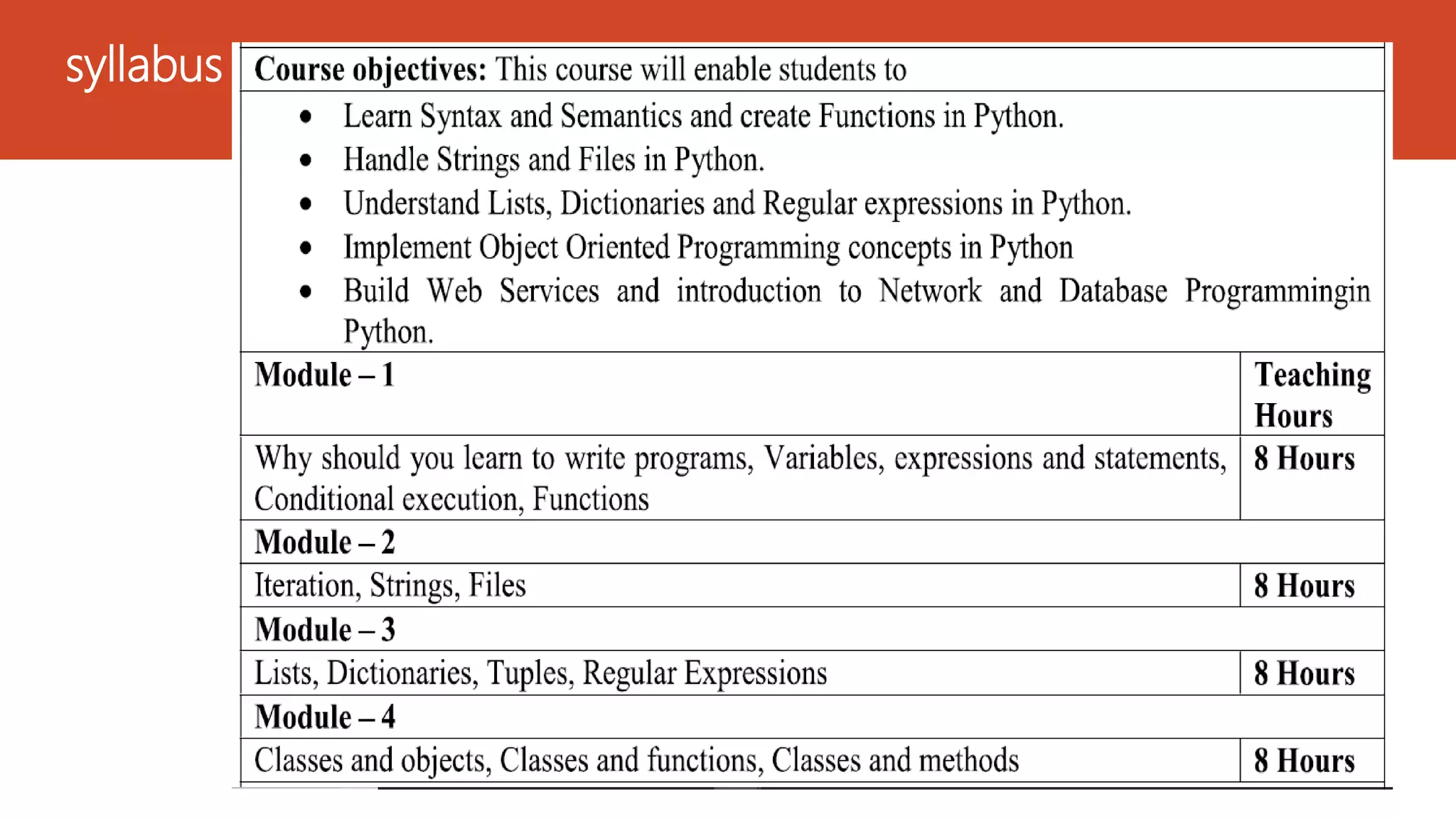
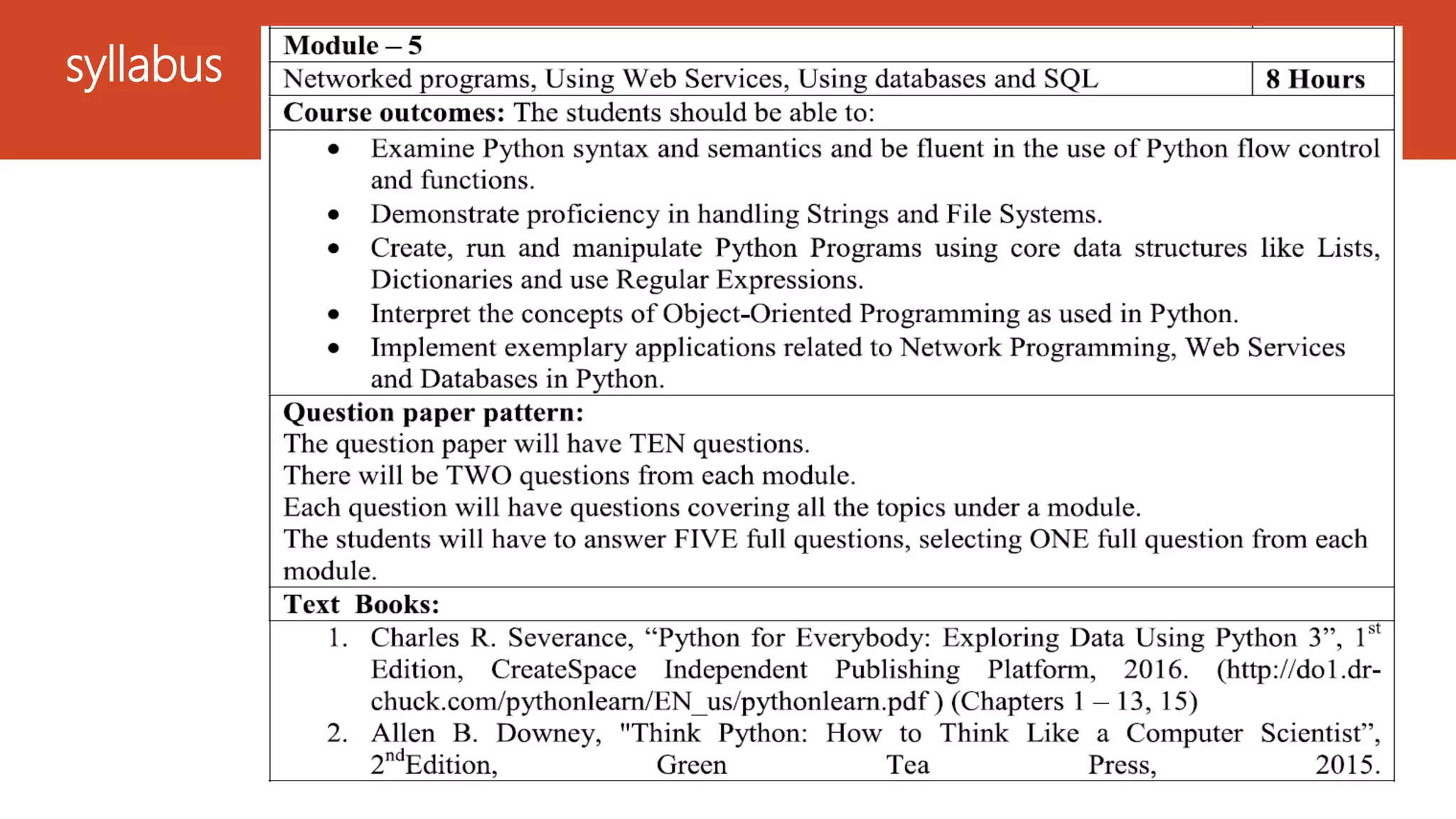
![Module - 3 : Lists List methods 1) append( ) Adds a new element to the end of a list: >>> t = ['a', 'b', 'c'] >>> t.append('d') >>> print(t) ['a', 'b', 'c', 'd'] 2) extend ( ) Takes a list as an argument and appends all of the elements: >>> t1 = ['a', 'b', 'c'] >>> t2 = ['d', 'e'] >>> t1.extend(t2) >>> print(t1) ['a', 'b', 'c', 'd', 'e'] This example leaves t2 unmodified. Most list methods are void; they modify the list and return None. t = t.sort(), the result will be nothing 3) Sort ( ) Arranges the elements of the list from low to high: >>> t = ['d', 'c', 'e', 'b', 'a'] >>> t.sort() >>> print(t) ['a', 'b', 'c', 'd', 'e']](https://image.slidesharecdn.com/syed-python-module3-180515155753/75/15CS664-Python-Application-Programming-Module-3-4-2048.jpg)
![Module - 3 : Lists List methods -Deleting Elements 4) pop( ) To delete elements from a list. If the index of the Element is known >>> t = ['a', 'b', 'c'] >>> x = t.pop(1) >>> print(t) ['a', 'c'] >>> print(x) b pop modifies the list and returns the element that was removed. If we don’t provide an index, it deletes and returns the last element. 5) del( ) If we don’t need the removed value, use the del operator: >>> t = ['a', 'b', 'c'] >>> del t[1] >>> print(t) ['a', 'c'] >>> t = ['a', 'b', 'c'] >>> x = t.pop( ) >>> print(t) ['a', ‘b'] >>> print(x) c](https://image.slidesharecdn.com/syed-python-module3-180515155753/75/15CS664-Python-Application-Programming-Module-3-5-2048.jpg)
![Module - 3 : Lists List methods -Deleting Elements 6) remove( ) If any element from the list to be removed , use remove: >>> t = ['a', 'b', 'c'] >>> t.remove('b') >>> print(t) ['a', 'c'] # The return value from remove is None. To remove more than one element, you can use del with a slice index: >>> t = ['a', 'b', 'c', 'd', 'e', 'f'] >>> del t[1:5] >>> print(t) ['a', 'f'] As usual, the slice selects all the elements up to, but not including, the second index.](https://image.slidesharecdn.com/syed-python-module3-180515155753/75/15CS664-Python-Application-Programming-Module-3-6-2048.jpg)
![Module - 3 : Lists Lists and functions There are a number of built-in functions that can be used on lists that allow to quickly look through a list without writing own loops: >>> nums = [3, 41, 12, 9, 74, 15] >>> print(len(nums)) 6 >>> print(max(nums)) 74 >>> print(min(nums)) 3 >>> print(sum(nums)) 154 >>> print(sum(nums)/len(nums)) # finding average 25 The sum() function only works when the list elements are numbers. The other functions (max(), len(), etc.) work with lists of strings and other types that can be comparable.](https://image.slidesharecdn.com/syed-python-module3-180515155753/75/15CS664-Python-Application-Programming-Module-3-7-2048.jpg)
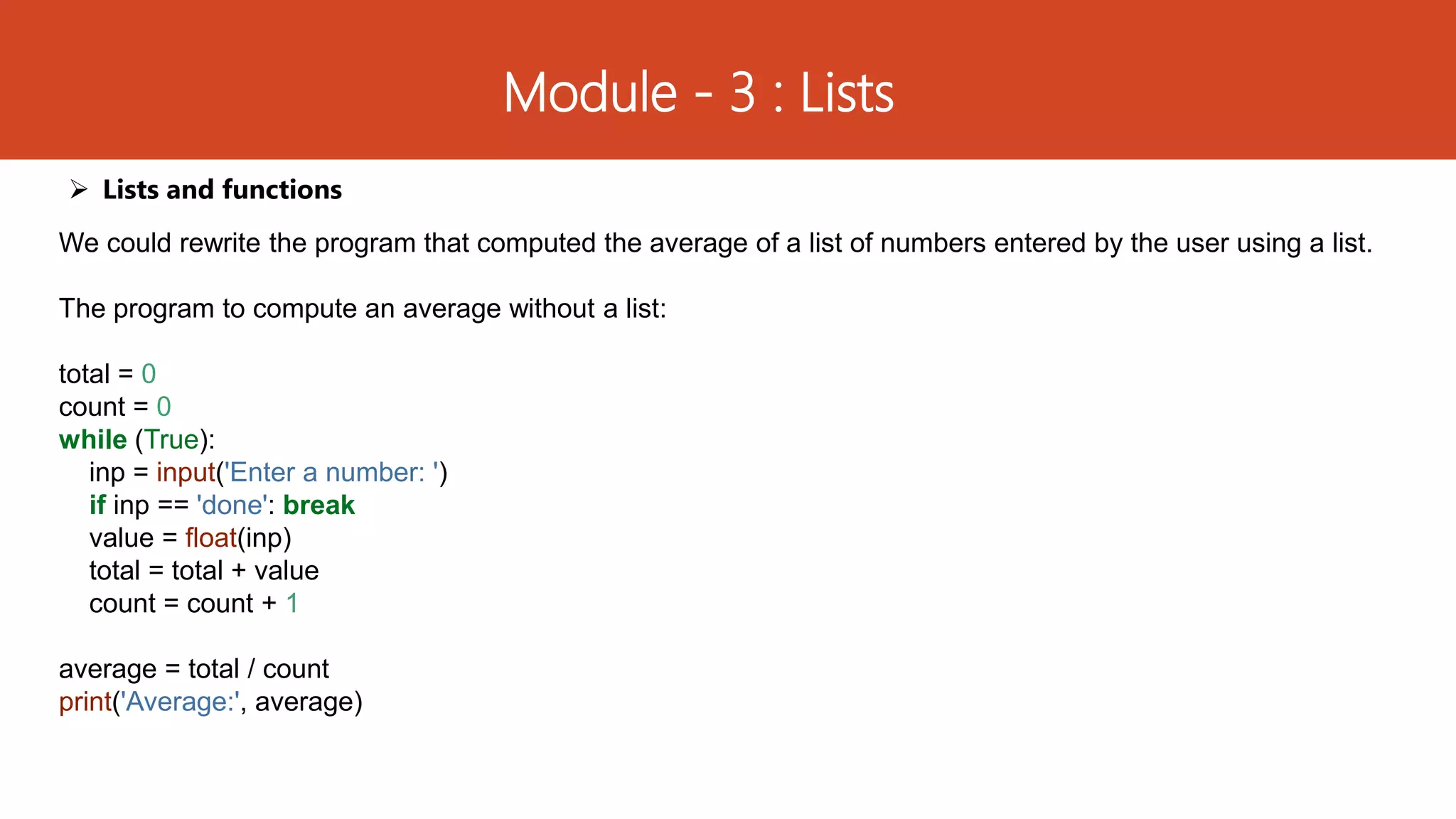
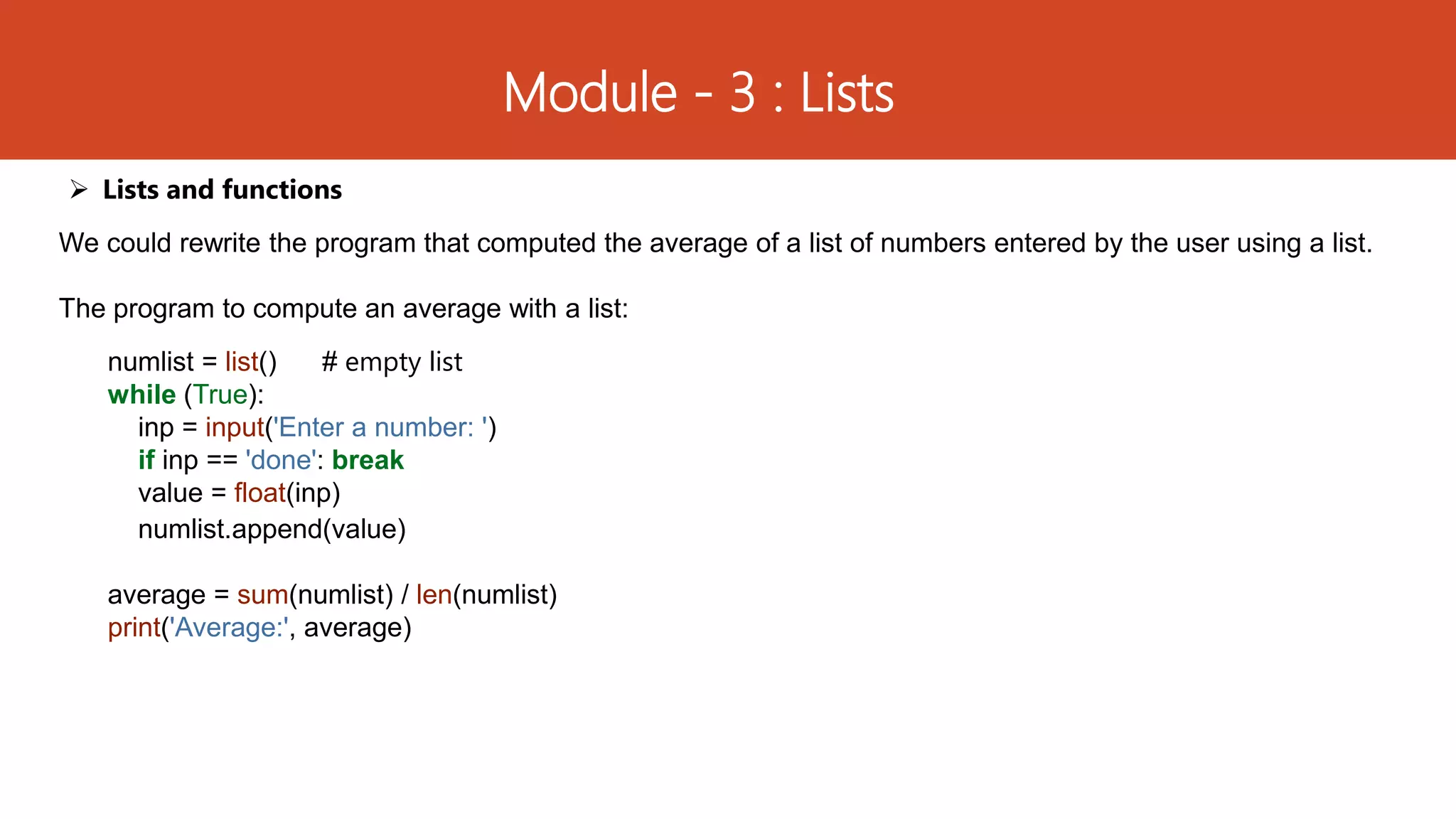
![Module - 3 : Lists Lists and Strings A string is a sequence of characters and a list is a sequence of values, but a list of characters is not the same as a string. To convert from a string to a list of characters, use list: >>> s = ‘HKBK' >>> t = list(s) >>> print(t) [‘H', ‘K', ‘B', ‘K'] The list function breaks a string into individual letters. If we want to break a string into words, use split method: >>> s = ‘Welcome to HKBKCE' >>> t = s.split() >>> print(t) [' Welcome ', ‘ to ‘, ‘ HKBKCE ’] >>> print(t[2]) HKBKCE](https://image.slidesharecdn.com/syed-python-module3-180515155753/75/15CS664-Python-Application-Programming-Module-3-10-2048.jpg)
![Module - 3 : Lists Lists and Strings We can call split with an optional argument called a delimiter that specifies which characters to use as word boundaries. The following example uses a hyphen as a delimiter: >>> s = 'spam-spam-spam' >>> delimiter = '-' >>> s.split(delimiter) ['spam', 'spam', 'spam'] Join( ) is the inverse of split. It takes a list of strings and concatenates the elements. join is a string method, so we have to invoke it on the delimiter and pass the list as a parameter: >>> t = [' Welcome ', ‘ to ‘, ‘ HKBKCE ’] >>> delimiter = ‘ ' >>> delimiter.join(t) ‘Welcome to HKBKCE’](https://image.slidesharecdn.com/syed-python-module3-180515155753/75/15CS664-Python-Application-Programming-Module-3-11-2048.jpg)
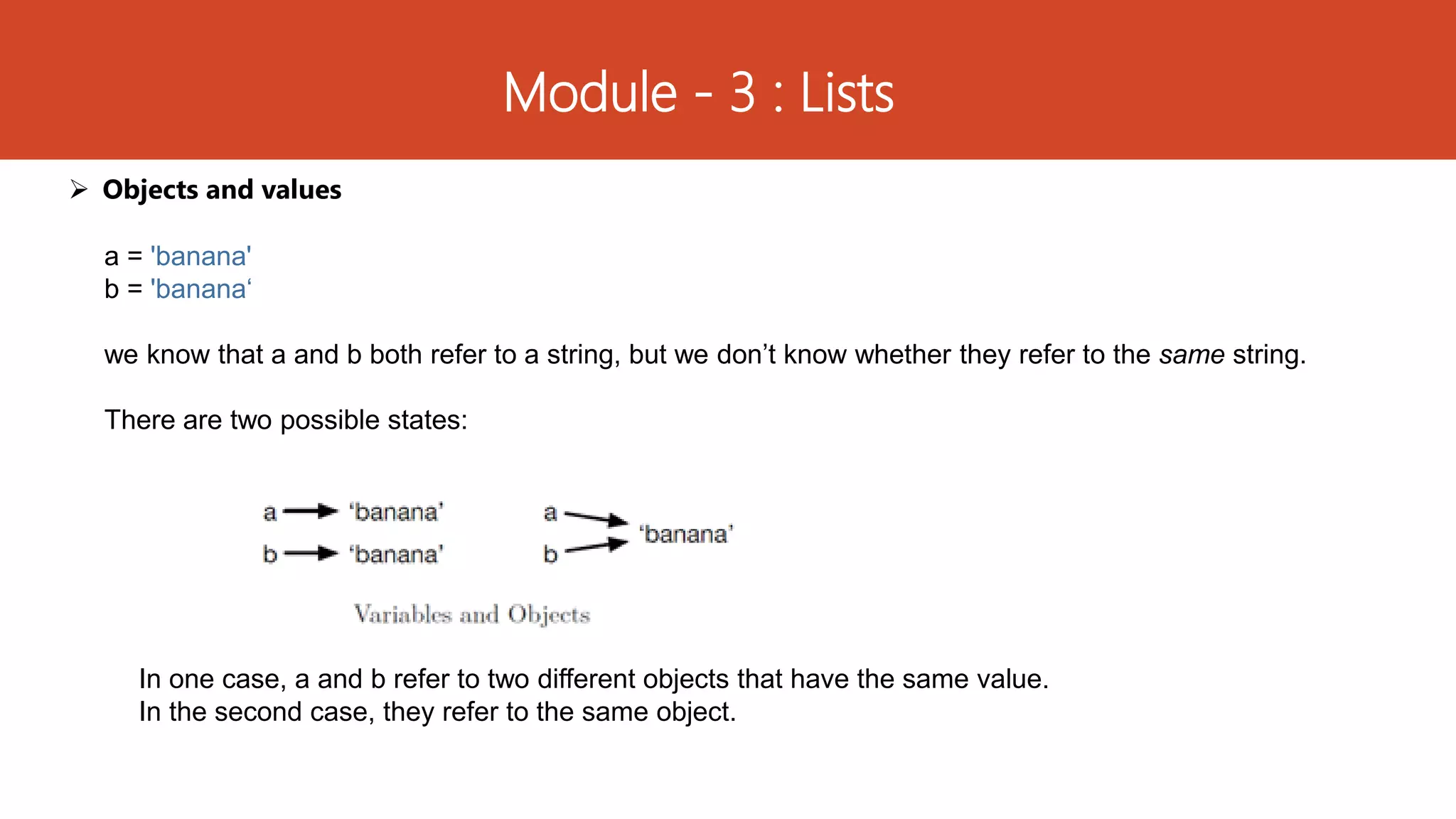
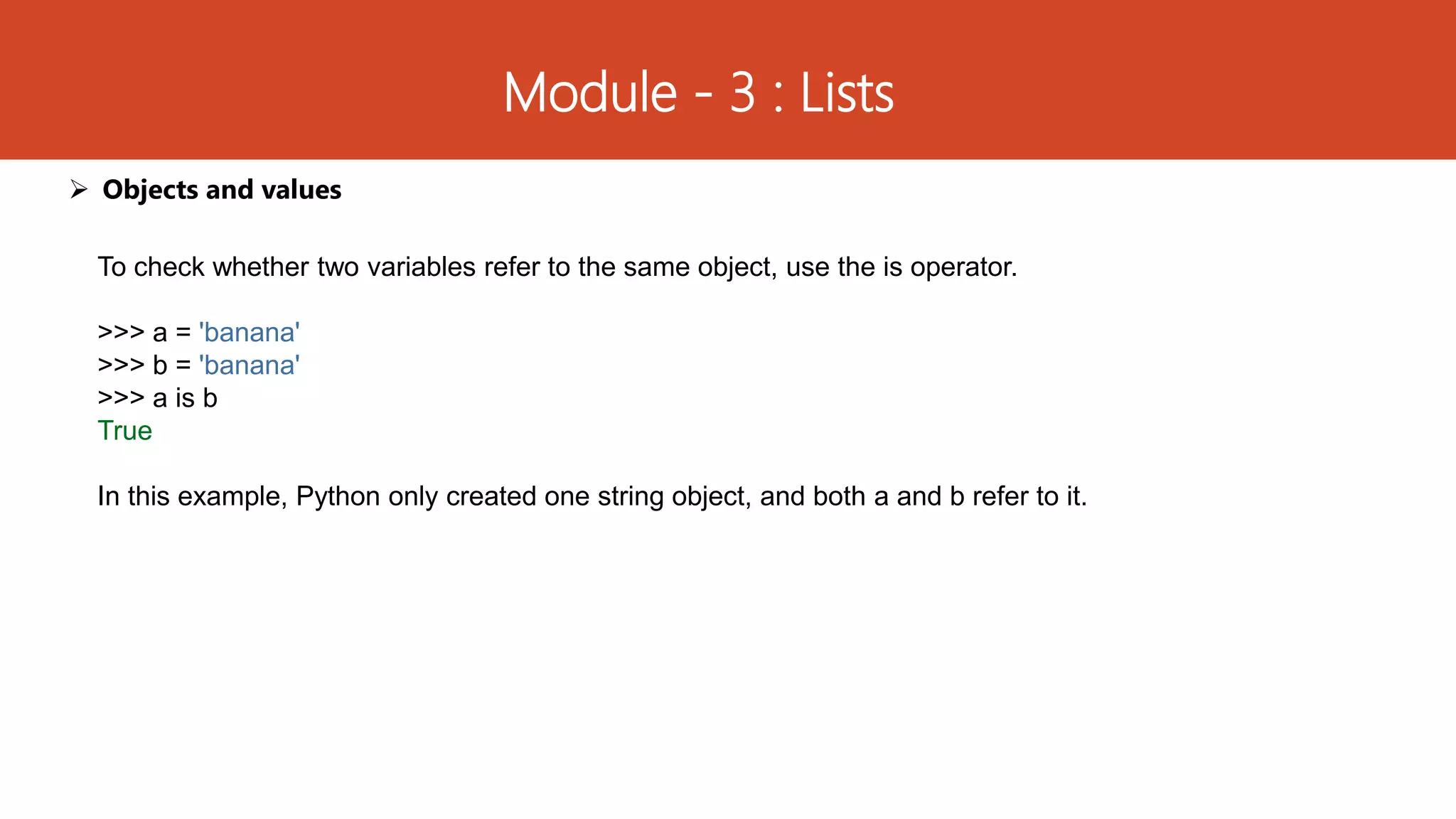
![Module - 3 : Lists Objects and values create two lists, we get two objects: >>> a = [1, 2, 3] >>> b = [1, 2, 3] >>> a is b False In this case , the two lists are equivalent, because they have the same elements, but not identical, because they are not the same object. If two objects are identical, they are also equivalent, but if they are equivalent, they are not necessarily identical.](https://image.slidesharecdn.com/syed-python-module3-180515155753/75/15CS664-Python-Application-Programming-Module-3-14-2048.jpg)
![Module - 3 : Lists Aliasing If a refers to an object and assign b = a, then both variables refer to the same object: >>> a = [1, 2, 3] >>> b = a >>> b is a True The association of a variable with an object is called a reference. In this example, there are two references to the same object. An object with more than one reference has more than one name, then the object is aliased.](https://image.slidesharecdn.com/syed-python-module3-180515155753/75/15CS664-Python-Application-Programming-Module-3-15-2048.jpg)
![Module - 3 : Lists Aliasing For immutable objects like strings, aliasing is not as much of a problem. a = 'banana' b = 'banana' it almost never makes a difference whether a and b refer to the same string or not. If the aliased object is mutable, changes made with one alias affect the other: >>> a = [1, 2, 3] >>> b = a >>> b[0] = 17 >>> print(a) [17, 2, 3]](https://image.slidesharecdn.com/syed-python-module3-180515155753/75/15CS664-Python-Application-Programming-Module-3-16-2048.jpg)
![Module - 3 : Lists List arguments When we pass a list to a function, the function gets a reference to the list. If the function modifies a list parameter, the caller sees the change. For example, delete_head removes the first element from a list: def delete_head(t): del t[0] >>> letters = ['a', 'b', 'c'] >>> delete_head(letters) >>> print(letters) ['b', 'c']](https://image.slidesharecdn.com/syed-python-module3-180515155753/75/15CS664-Python-Application-Programming-Module-3-17-2048.jpg)
![Module - 3 : Lists List arguments The parameter t and the variable letters are aliases for the same object. It is important to distinguish between operations that modify lists and operations that create new lists. For example, the append method modifies a list, but the + operator creates a new list: >>> t1 = [1, 2] >>> t2 = t1.append(3) >>> print(t1) [1, 2, 3] >>> print(t2) None >>> t3 = t1 + [3] >>> print(t3) [1, 2, 3] >>> t2 is t3 False](https://image.slidesharecdn.com/syed-python-module3-180515155753/75/15CS664-Python-Application-Programming-Module-3-18-2048.jpg)
![Module - 3 : Lists List arguments This difference is important when we write functions that are supposed to modify lists. For example, this function does not delete the head of a list: def bad_delete_head(t): t = t[1:] # WRONG! The slice operator creates a new list and the assignment makes t refer to it, but none of that has any effect on the list that was passed as an argument. An alternative is to write a function that creates and returns a new list. For example, tail returns all but the first element of a list: def tail(t): return t[1:] #This function leaves the original list unmodified. Here’s how it is used: >>> letters = ['a', 'b', 'c'] >>> rest = tail(letters) >>> print(rest) ['b', 'c']](https://image.slidesharecdn.com/syed-python-module3-180515155753/75/15CS664-Python-Application-Programming-Module-3-19-2048.jpg)
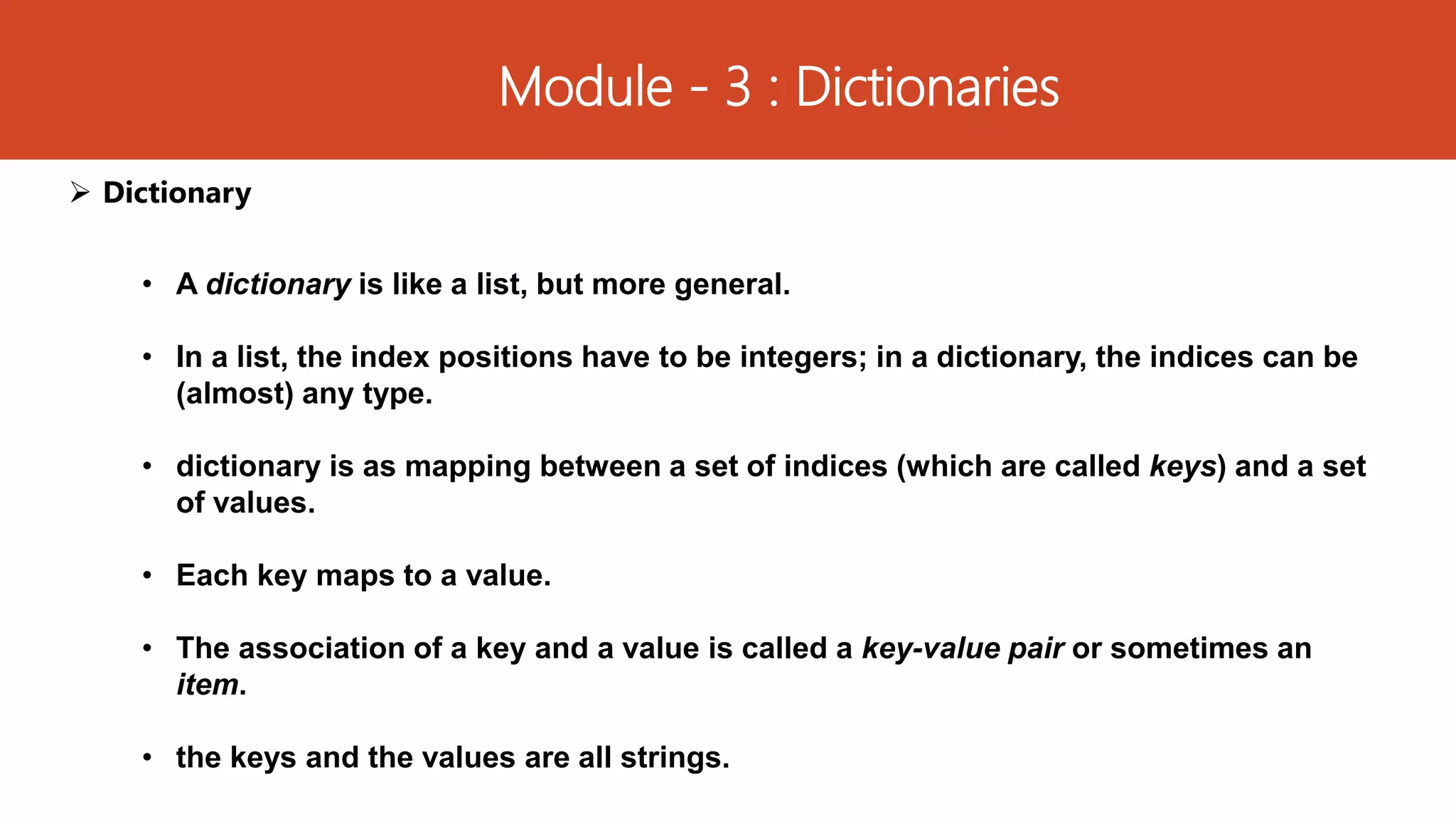
![Module - 3 : Dictionaries Dictionary The function dict() creates a new dictionary with no items. Because dict is the name of a built-in function, we should avoid using it as a variable name. >>> city_capital = dict() >>> print(city_capital) { } # The curly brackets, { }, represent an empty dictionary. To add items to the dictionary, use square brackets: >>> city_capital[‘KAR'] = ‘Bangalore‘ This line creates an item that maps from the key ’KAR’ to the value “Bangalore”. If we print the dictionary again, we see a key-value pair with a colon between the key and value: >>> print(city_capital) {‘KAR': ‘Bangalore'}](https://image.slidesharecdn.com/syed-python-module3-180515155753/75/15CS664-Python-Application-Programming-Module-3-21-2048.jpg)
![Module - 3 : Dictionaries Dictionary >>> city_capital={'KAR':'Bangalore','TN':'Chennai','AP':'Hyderabad'} >>> print(city_capital) {'KAR': 'Bangalore', 'TN': 'Chennai', 'AP': 'Hyderabad'} The order of the key-value pairs is not the same. In general, the order of items in a dictionary is unpredictable. Use the keys to look up the corresponding values: >>> print(city_capital['TN']) Chennai If the key isn’t in the dictionary, we get an exception: >>> print(city_capital[‘KN']) KeyError: ‘KN'](https://image.slidesharecdn.com/syed-python-module3-180515155753/75/15CS664-Python-Application-Programming-Module-3-22-2048.jpg)
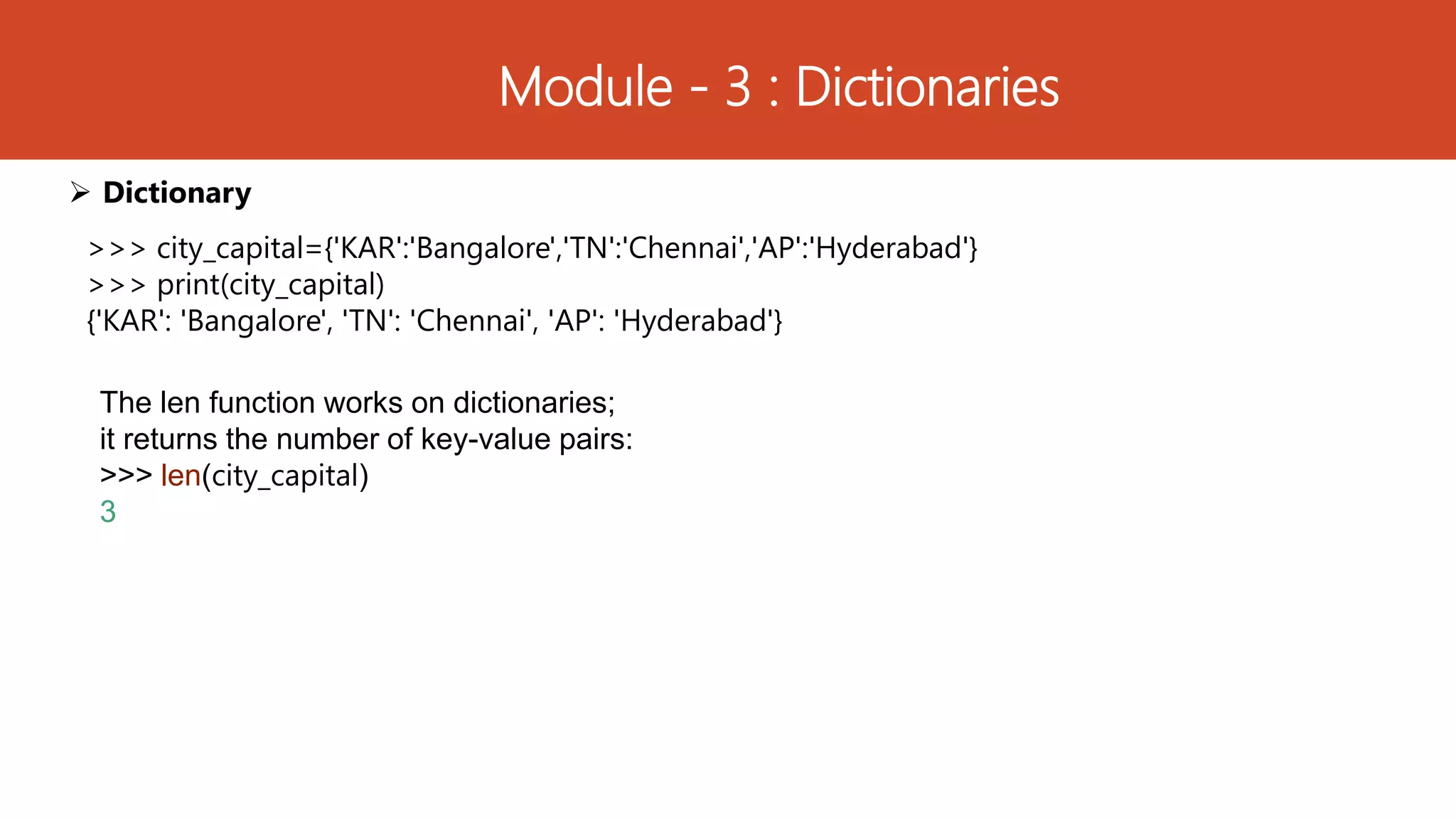
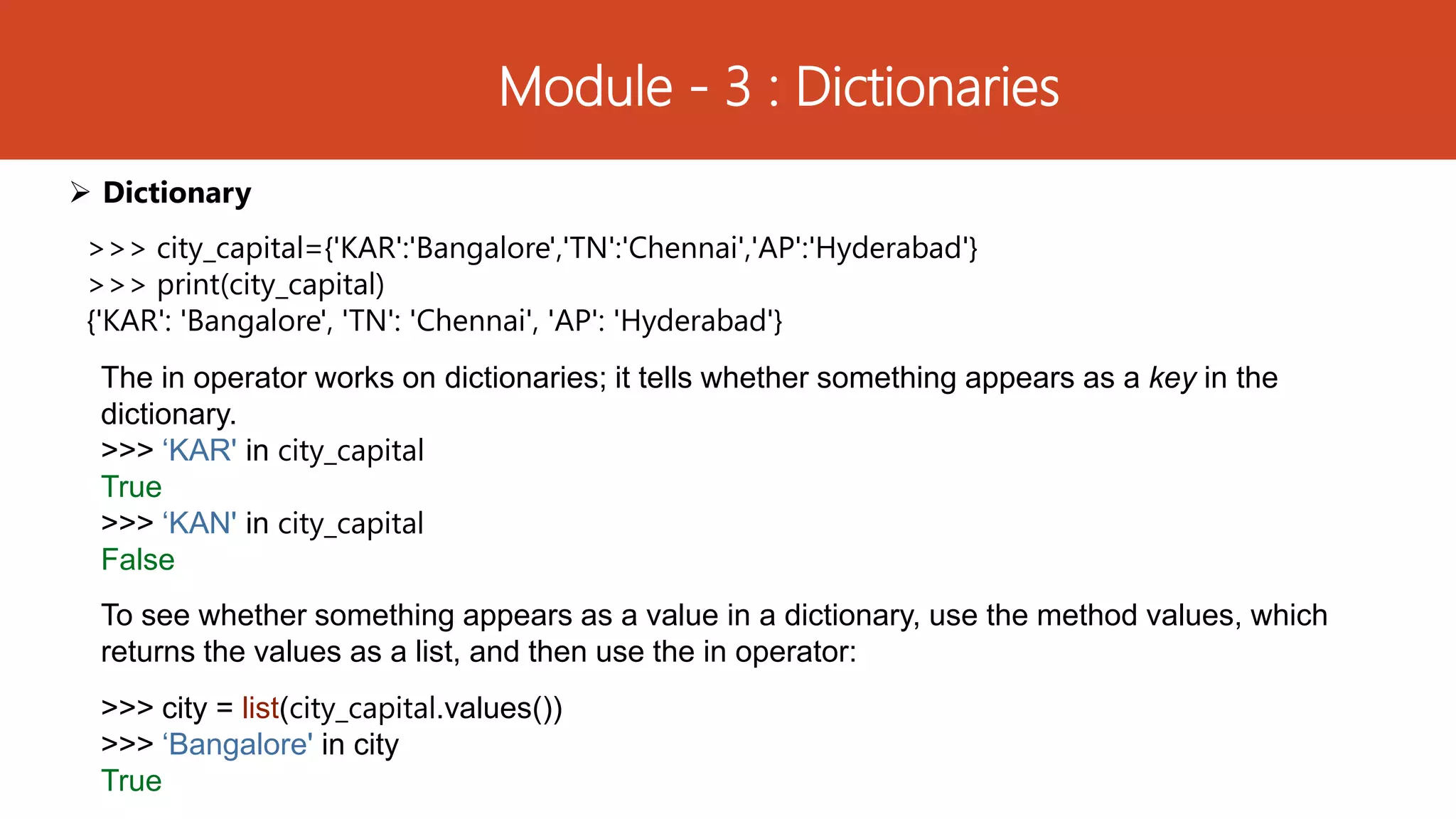
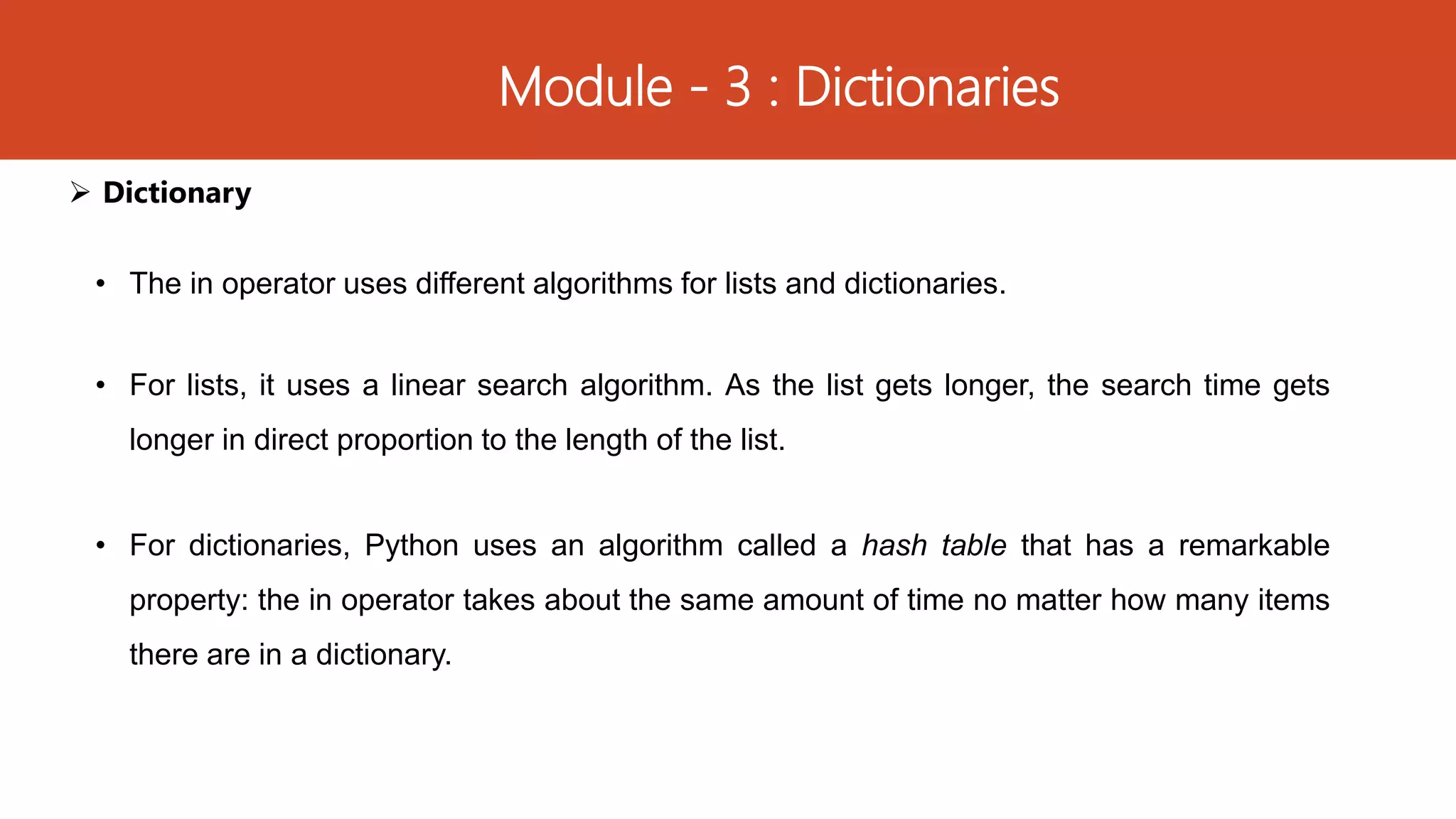
![Module - 3 : Dictionaries Dictionary as a set of counters str = 'Good Morning God Mother' d = dict() for ch in str: if ch not in d: d[ch] = 1 else: d[ch] = d[ch] + 1 print(d) {'G': 2, 'o': 5, 'd': 2, ' ': 3, 'M': 2, 'r': 2, 'n': 2, 'i': 1, 'g': 1, 't': 1, 'h': 1, 'e': 1} We are effectively computing a histogram, which is a statistical term for a set of counters (or frequencies).](https://image.slidesharecdn.com/syed-python-module3-180515155753/75/15CS664-Python-Application-Programming-Module-3-26-2048.jpg)
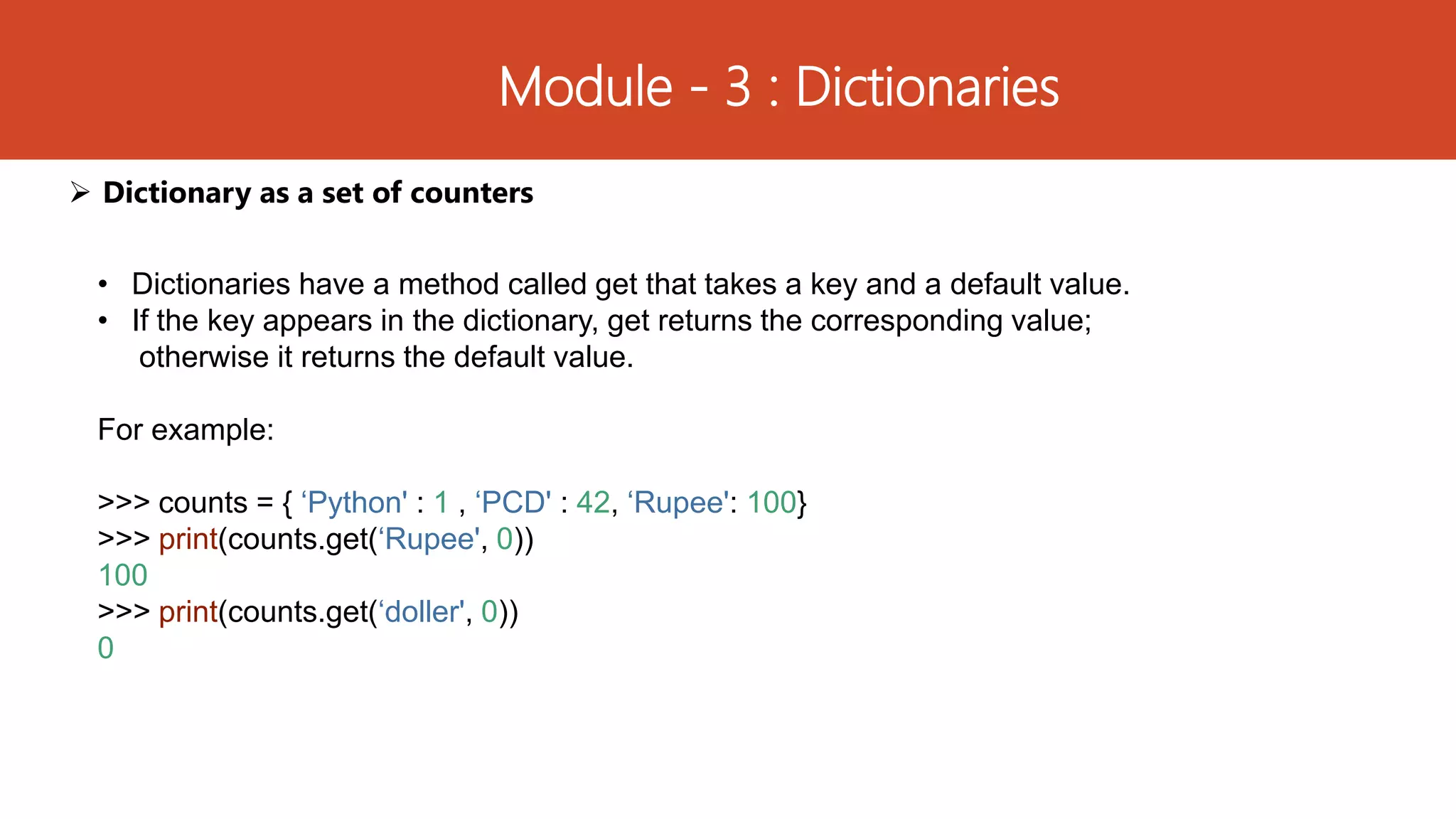
![Module - 3 : Dictionaries Dictionary as a set of counters str = 'Good Morning God Mother' d = dict( ) for ch in str: d[ch] = d.get(ch,0) + 1 print(d) {'G': 2, 'o': 5, 'd': 2, ' ': 3, 'M': 2, 'r': 2, 'n': 2, 'i': 1, 'g': 1, 't': 1, 'h': 1, 'e': 1} We can use get to write our histogram loop more concisely. Because the get method automatically handles the case where a key is not in a dictionary, we can reduce four lines down to one and eliminate the if statement.](https://image.slidesharecdn.com/syed-python-module3-180515155753/75/15CS664-Python-Application-Programming-Module-3-28-2048.jpg)
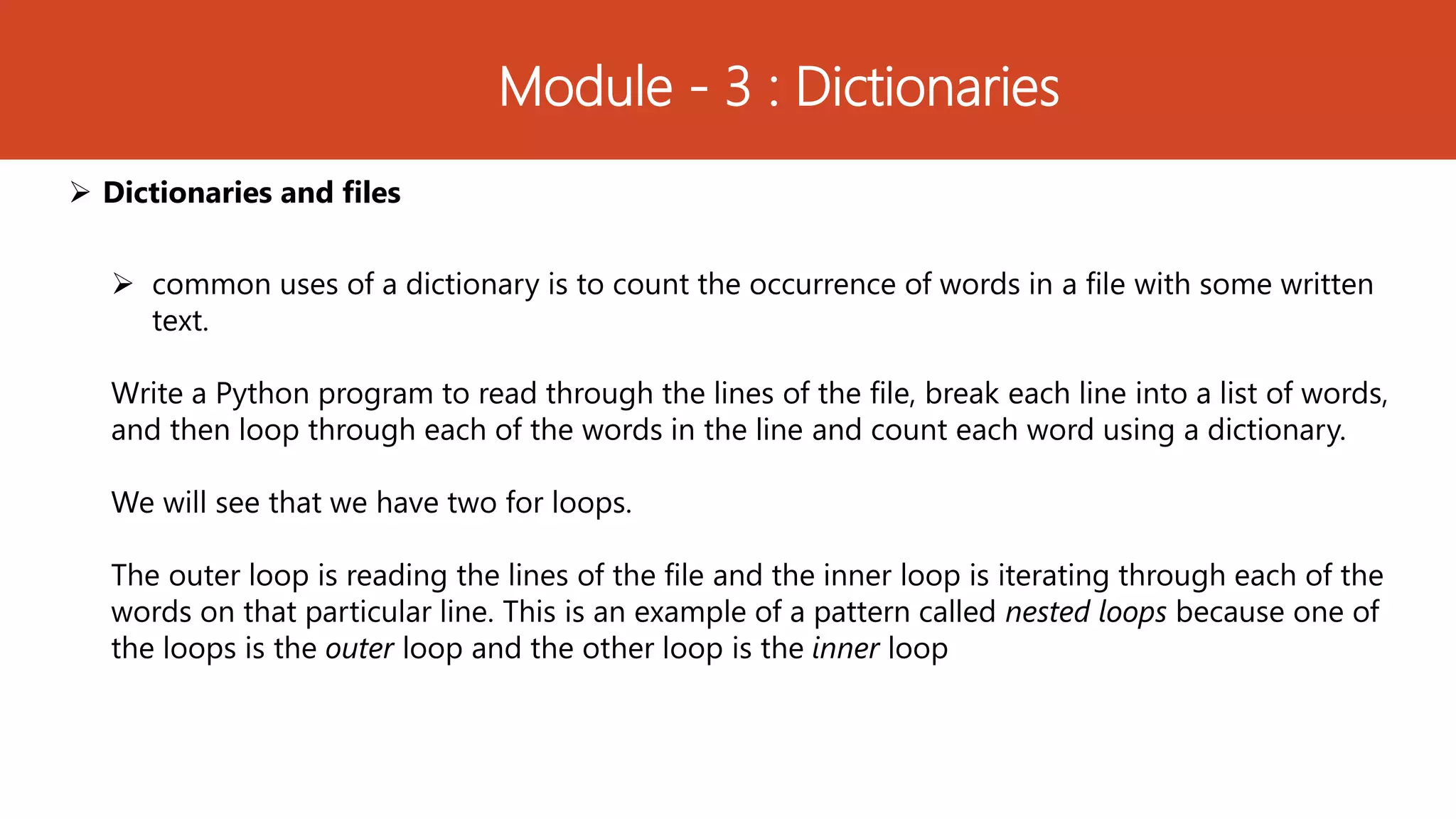
![Module - 3 : Dictionaries Dictionaries and files fname = input('Enter the file name: ') try: fhand = open(fname) except: print('File cannot be opened:', fname) exit() counts = dict() for line in fhand: words = line.split() for word in words: if word not in counts: counts[word] = 1 else: counts[word] += 1 print(counts) Enter the file name: hkbk.txt {'HKBK': 2, 'College': 1, 'of': 2, 'Engineering': 1, 'was': 1, 'established': 1, 'in': 2, '1997.': 1, 'Teaching': 1, 'is': 2, 'more': 1, 'than': 1, 'a': 2, 'profession,': 1, 'for': 1, 'the': 1, 'faculty': 1, 'members': 1, 'HKBKCE': 2, 'situated': 1, 'Bangalore': 1, 'We': 1, 'are': 1, 'proud': 1, 'to': 1, 'be': 1, 'Students.': 1} HKBK.txt HKBK College of Engineering was established in 1997. Teaching is more than a profession, for the faculty members of HKBKCE HKBKCE is situated in Bangalore We are proud to be a HKBK Students.](https://image.slidesharecdn.com/syed-python-module3-180515155753/75/15CS664-Python-Application-Programming-Module-3-30-2048.jpg)
![Module - 3 : Dictionaries Looping and dictionaries If we use a dictionary as the sequence in a for statement, it traverses the keys of the dictionary. This loop prints each key and the corresponding value: counts = { 'BNG' : 1 , 'MYS' : 42, 'SMG': 100} for key in counts: print(key, counts[key]) Output: BNG 1 MYS 42 SMG 100](https://image.slidesharecdn.com/syed-python-module3-180515155753/75/15CS664-Python-Application-Programming-Module-3-31-2048.jpg)
![Module - 3 : Dictionaries Looping and dictionaries If we want to print the keys in alphabetical order, 1. make a list of the keys in the dictionary using the keys method available in dictionary objects 2. sort that list and loop through the sorted list, looking up each key Program for Printing out key-value pairs in sorted order as follows: Output: ['SMG', 'MYS', 'BNG'] BNG 100 MYS 42 SMG 1 counts = {'SMG' : 1 , 'MYS' : 42, 'BNG' : 100} lst = list(counts.keys()) print(lst) lst.sort() for key in lst: print(key, counts[key])](https://image.slidesharecdn.com/syed-python-module3-180515155753/75/15CS664-Python-Application-Programming-Module-3-32-2048.jpg)
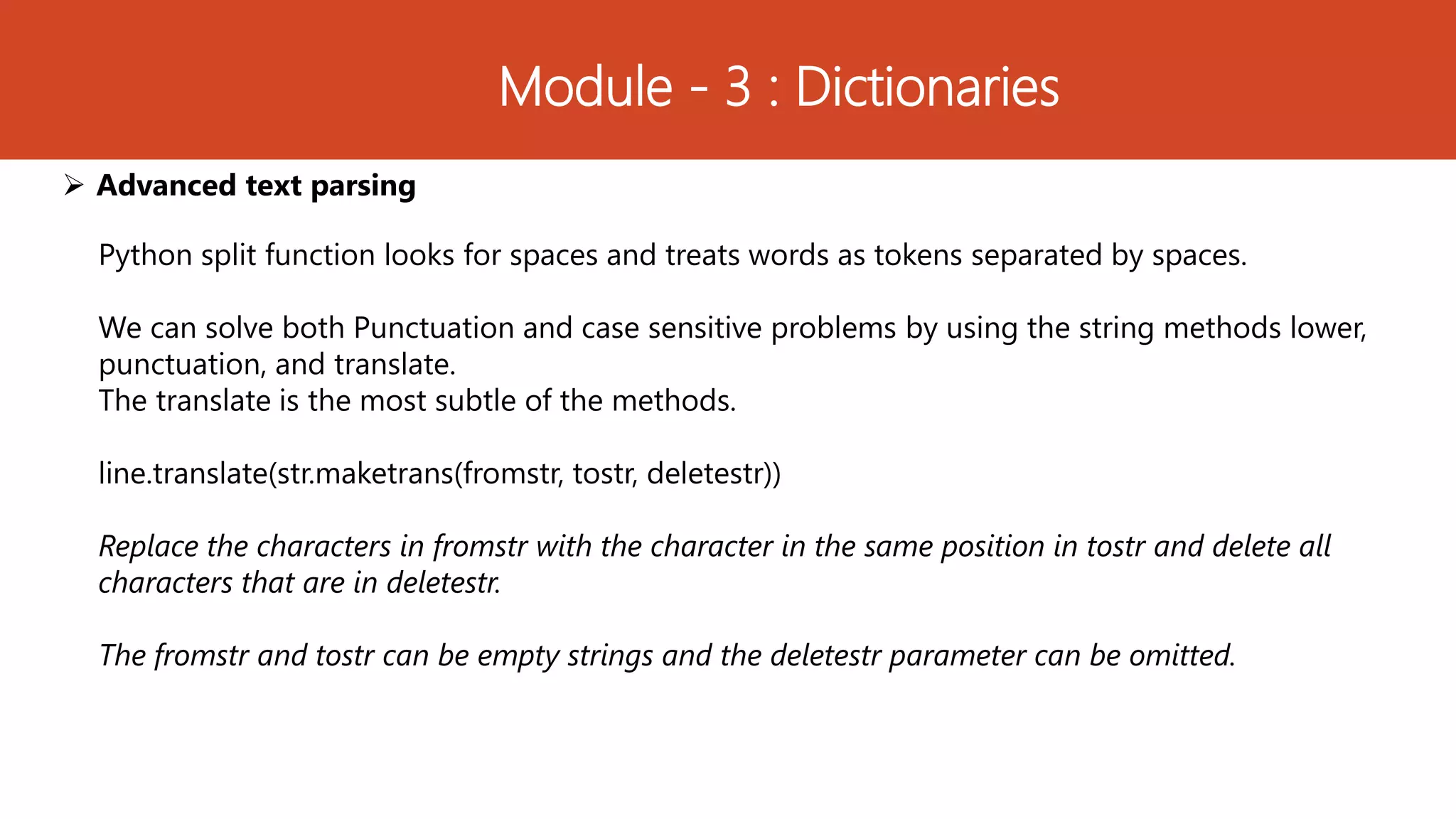
![Module - 3 : Dictionaries Advanced text parsing >>> import string >>> string.punctuation '!"#$%&'()*+,-./:;<=>?@[]^_`{|}~‘ HKBKpunch.txt Greetings from HKBKCE! Hello, How are You? HKBK College of Engineering was established in 1997. Teaching is more than a profession, for the faculty members of HKBKCE HKBKCE is situated in Bangalore We are proud to be a HKBK Students.](https://image.slidesharecdn.com/syed-python-module3-180515155753/75/15CS664-Python-Application-Programming-Module-3-34-2048.jpg)
![Module - 3 : Dictionaries Advanced text parsingimport string fname = input('Enter the file name: ') #counting words program try: fhand = open(fname) except: print('File cannot be opened:', fname) exit() counts = dict() for line in fhand: line = line.rstrip() line = line.translate(line.maketrans('', '', string.punctuation)) line = line.lower() words = line.split() for word in words: if word not in counts: counts[word] = 1 else: counts[word] += 1 print(counts) Output: Enter the file name: HKBKpunch.txt {'greetings': 1, 'from': 1, 'hkbkce': 3, 'hello': 1, 'how': 1, 'are': 2, 'you': 1, 'hkbk': 2, 'college': 1, 'of': 2, 'engineering': 1, 'was': 1, 'established': 1, 'in': 2, '1997': 1, 'teaching': 1, 'is': 2, 'more': 1, 'than': 1, 'a': 2, 'profession': 1, 'for': 1, 'the': 1, 'faculty': 1, 'members': 1, 'situated': 1, 'bangalore': 1, 'we': 1, 'proud': 1, 'to': 1, 'be': 1, 'students': 1}](https://image.slidesharecdn.com/syed-python-module3-180515155753/75/15CS664-Python-Application-Programming-Module-3-35-2048.jpg)
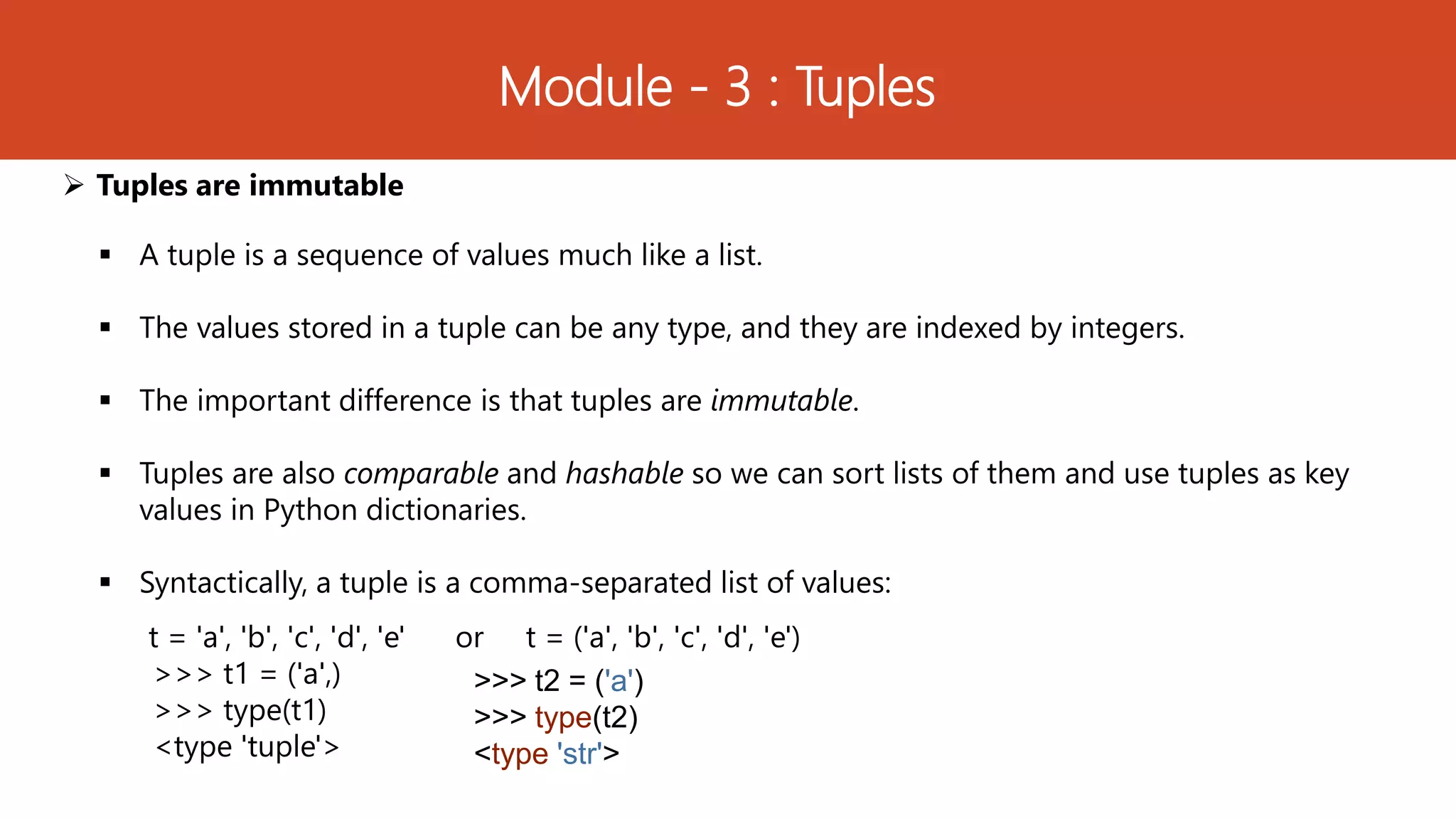
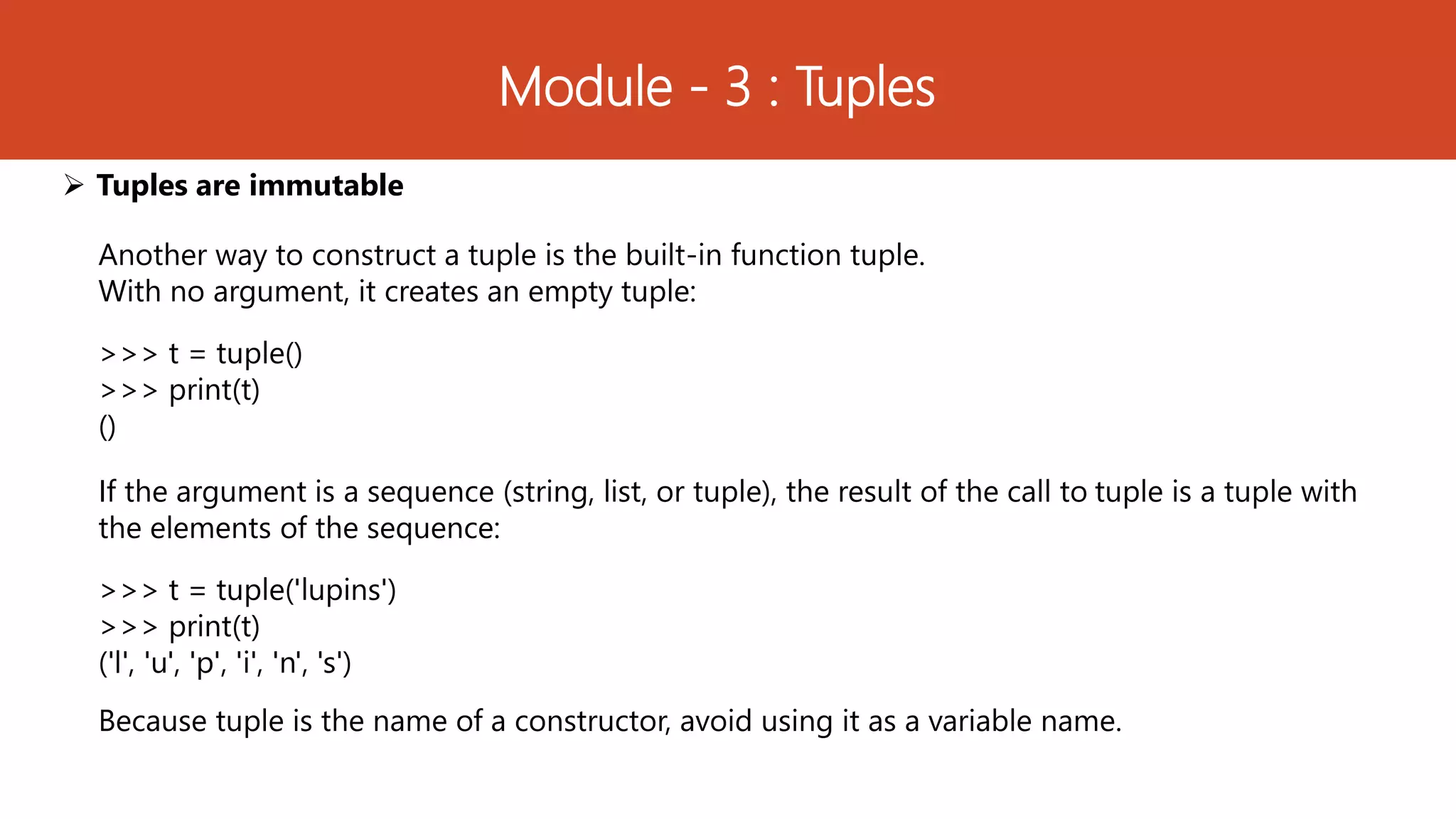
![Module - 3 : Tuples Tuples are immutable Most list operators also work on tuples. The bracket operator indexes an element: >>> t = ('a', 'b', 'c', 'd', 'e') >>> print(t[0]) 'a' slice operator selects a range of elements: >>> print(t[1:3]) ('b', 'c')](https://image.slidesharecdn.com/syed-python-module3-180515155753/75/15CS664-Python-Application-Programming-Module-3-38-2048.jpg)
![Module - 3 : Tuples Tuples are immutable But if try to modify one of the elements of the tuple, will get an error: >>> t[0] = 'A' TypeError: object doesn't support item assignment We can’t modify the elements of a tuple, but We can replace one tuple with another: >>> t = ('A',) + t[1:] >>> print(t) ('A', 'b', 'c', 'd', 'e')](https://image.slidesharecdn.com/syed-python-module3-180515155753/75/15CS664-Python-Application-Programming-Module-3-39-2048.jpg)
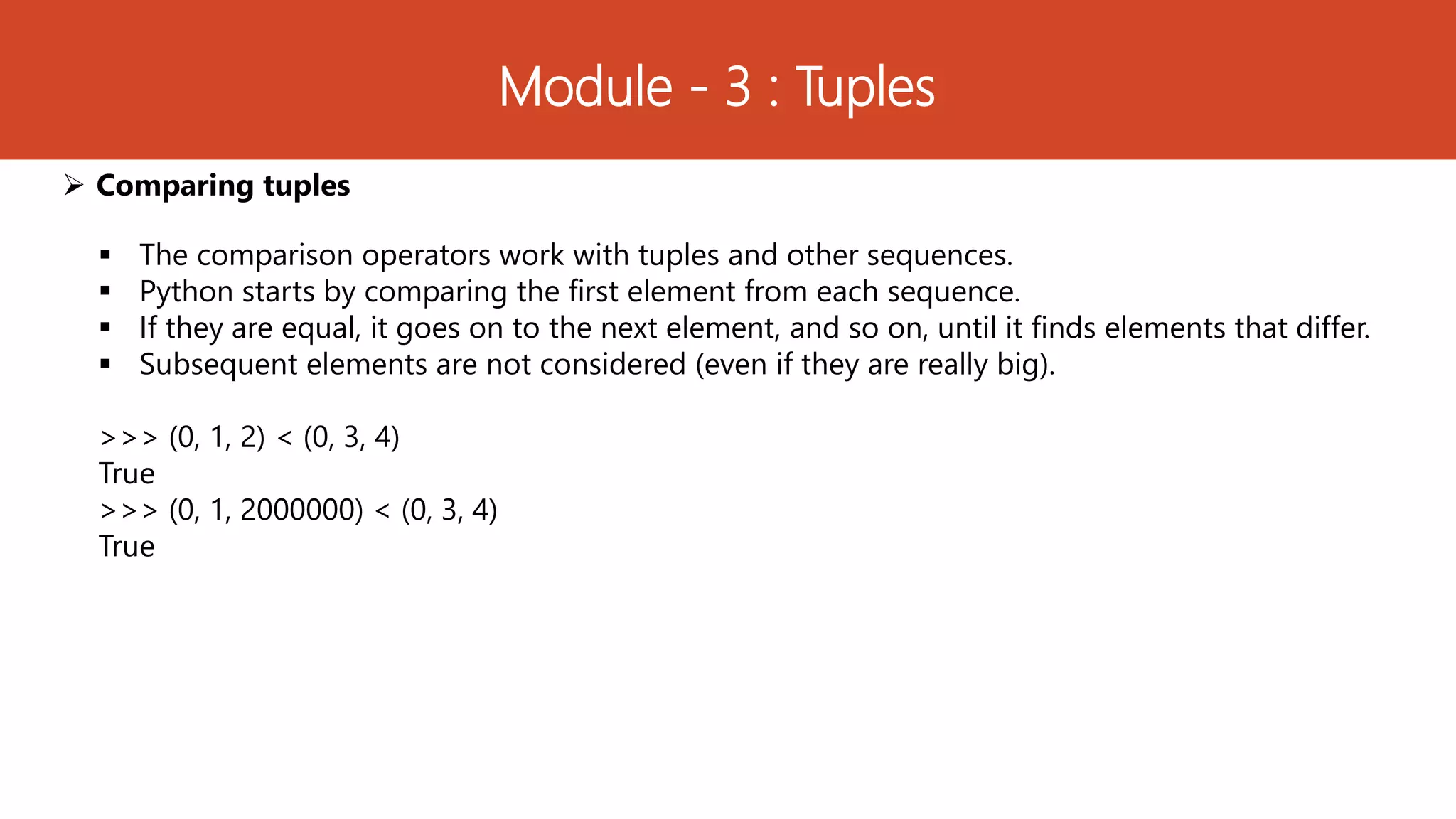
![Module - 3 : Tuples Comparing tuples The sort function works the same way. It sorts primarily by first element, but in the case of a tie, it sorts by second element, and so on. This feature lends itself to a pattern called DSU for Decorate a sequence by building a list of tuples with one or more sort keys preceding the elements from the sequence, Sort the list of tuples using the Python built-in sort, and Undecorate by extracting the sorted elements of the sequence. [DSU]](https://image.slidesharecdn.com/syed-python-module3-180515155753/75/15CS664-Python-Application-Programming-Module-3-41-2048.jpg)
![Module - 3 : Tuples Comparing tuples #Program to sort list of words from shortest to longest txt = 'HKBK College of Engineering was established in 1997' words = txt.split() t = list() for word in words: t.append((len(word), word)) print(t) t.sort() print(t) res = list() for length, word in t: res.append(word) print(res) Output: [(4, 'HKBK'), (7, 'College'), (2, 'of'), (11, 'Engineering'), (3, 'was'), (11, 'established'), (2, 'in'), (4, '1997')] [(2, 'in'), (2, 'of'), (3, 'was'), (4, '1997'), (4, 'HKBK'), (7, 'College'), (11, 'Engineering'), (11, 'established')] ['in', 'of', 'was', '1997', 'HKBK', 'College', 'Engineering', 'established']](https://image.slidesharecdn.com/syed-python-module3-180515155753/75/15CS664-Python-Application-Programming-Module-3-42-2048.jpg)
![Module - 3 : Tuples Tuple assignment One of the unique syntactic features of the Python language is the ability to have a tuple on the left side of an assignment statement. This allows to assign more than one variable at a time when the left side is a sequence. Two-element list (which is a sequence) and assign the first and second elements of the sequence to the variables x and y in a single statement. >>> m = [ 'have', 'fun' ] >>> x, y = m >>> x 'have' >>> y 'fun' >>> >>> m = [ 'have', 'fun' ] >>> x = m[0] >>> y = m[1] >>> x 'have' >>> y 'fun' >>> >>> m = [ 'have', 'fun' ] >>> (x, y) = m >>> x 'have' >>> y 'fun' >>>](https://image.slidesharecdn.com/syed-python-module3-180515155753/75/15CS664-Python-Application-Programming-Module-3-43-2048.jpg)
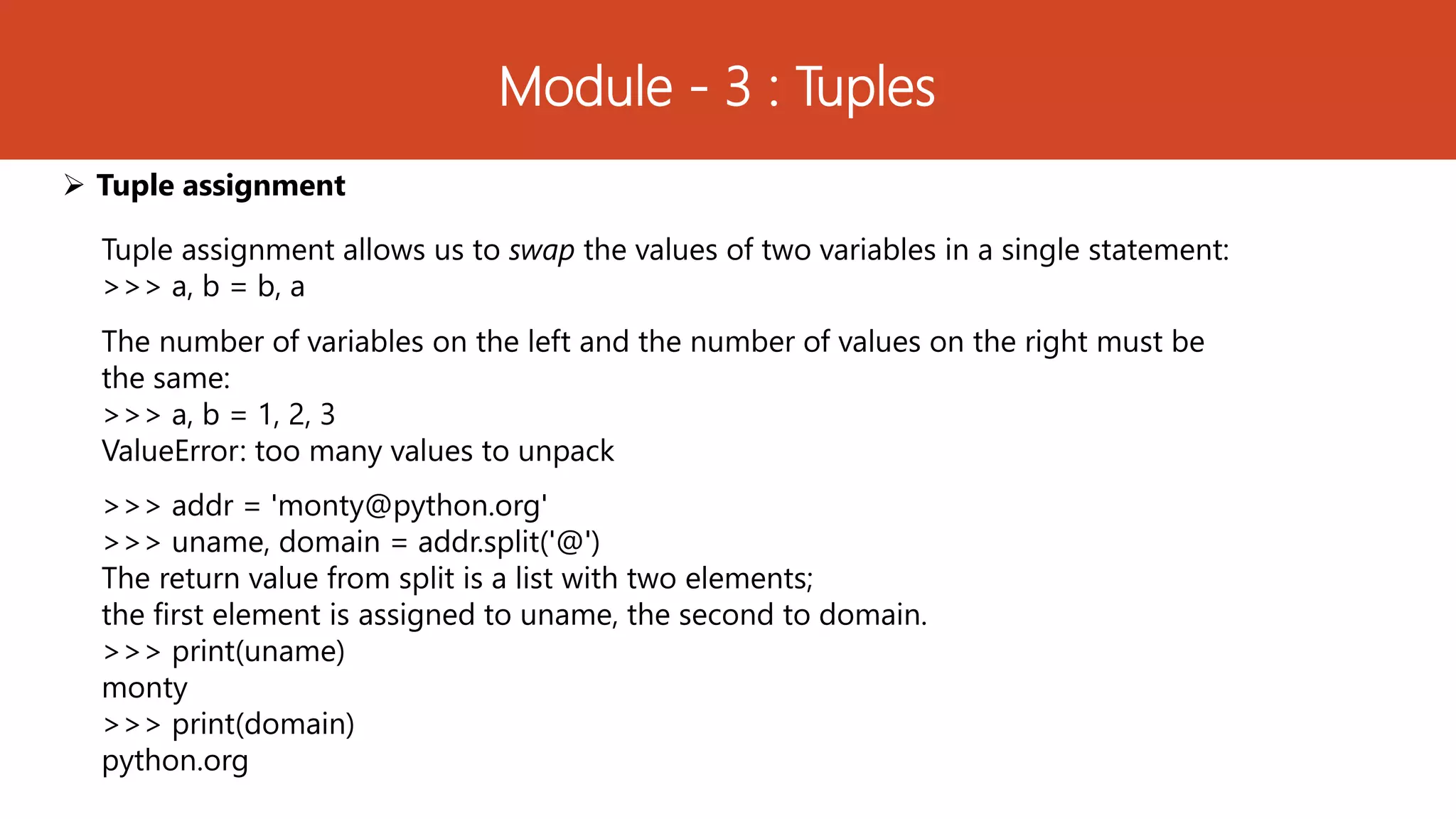
![Module - 3 : Tuples Dictionaries and tuples Dictionaries have a method called items. Item() returns a list of tuples, where each tuple is a key-value pair: >>> d = {'a':10, 'b':1, 'c':22} >>> t = list(d.items()) >>> print(t) [('b', 1), ('a', 10), ('c', 22)] As we should expect from a dictionary, the items are in no particular order.](https://image.slidesharecdn.com/syed-python-module3-180515155753/75/15CS664-Python-Application-Programming-Module-3-45-2048.jpg)
![Module - 3 : Tuples Dictionaries and tuples sort the list of tuples. Converting a dictionary to a list of tuples is a way for us to output the contents of a dictionary sorted by key: >>> d = {'a':10, 'b':1, 'c':22} >>> t = list(d.items()) >>> t [('b', 1), ('a', 10), ('c', 22)] >>> t.sort() >>> t [('a', 10), ('b', 1), ('c', 22)] The new list is sorted in ascending alphabetical order by the key value.](https://image.slidesharecdn.com/syed-python-module3-180515155753/75/15CS664-Python-Application-Programming-Module-3-46-2048.jpg)
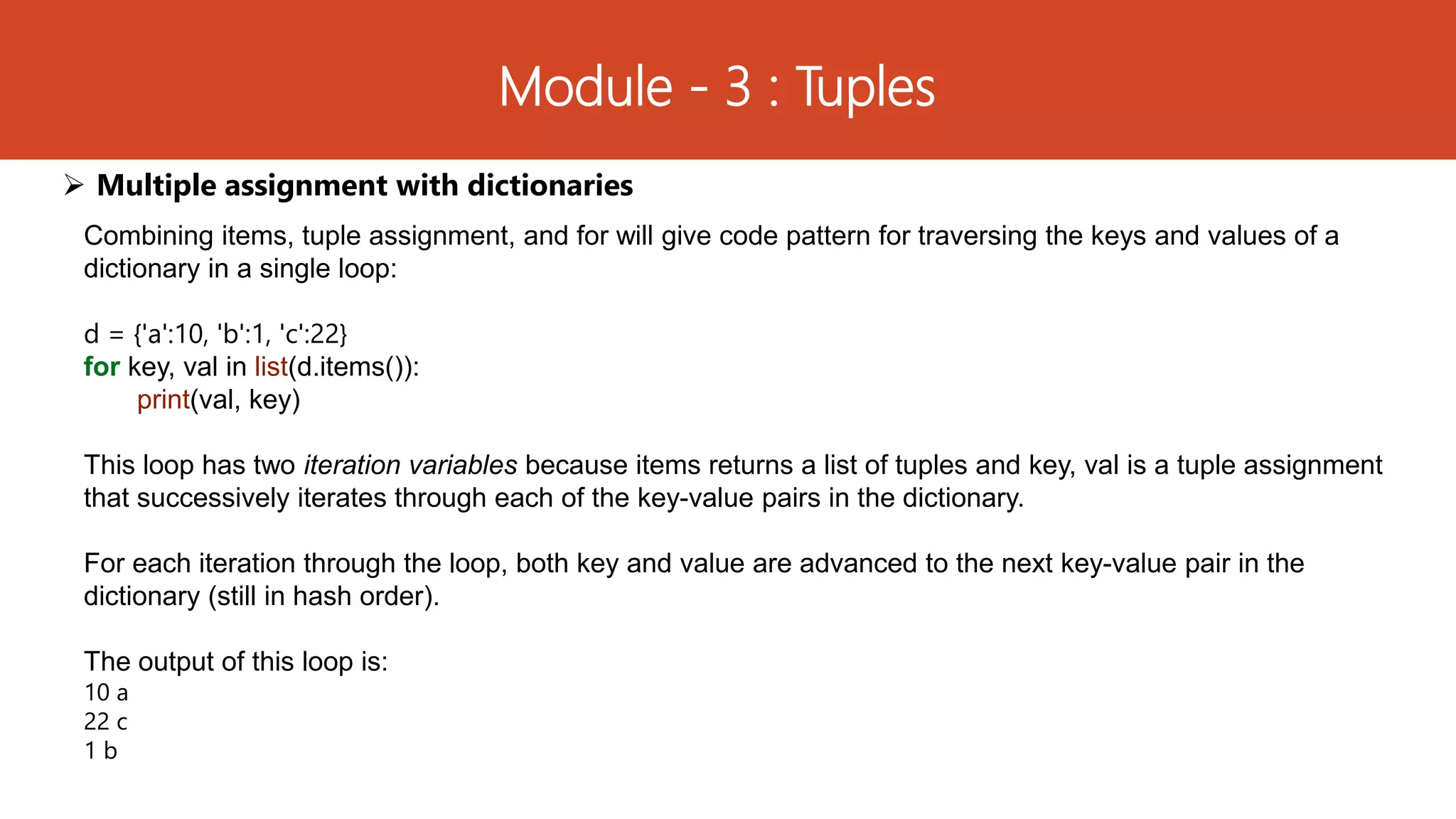
![Module - 3 : Tuples The most common words #program to count words import string fhand = open('HKBKpunch.txt') counts = dict() for line in fhand: line = line.translate(str.maketrans('', '', string.punctuation)) line = line.lower() words = line.split() for word in words: if word not in counts: counts[word] = 1 else: counts[word] += 1 # Sort the dictionary by value lst = list() for key, val in list(counts.items()): lst.append((val, key)) lst.sort(reverse=True) for key, val in lst[:10]: print(key, val) Output: 3 hkbkce 2 of 2 is 2 in 2 hkbk 2 are 2 a 1 you 1 we 1 was The fact that this complex data parsing and analysis can be done with an easy-to understand Python program is one reason why Python is a good choice as a language for exploring information](https://image.slidesharecdn.com/syed-python-module3-180515155753/75/15CS664-Python-Application-Programming-Module-3-48-2048.jpg)
![Module - 3 : Tuples Using tuples as keys in dictionaries Define the variables last, first, and number, we could write a dictionary assignment statement as follows: directory[last,first] = number The expression in brackets is a tuple. We could use tuple assignment in a for loop to traverse this dictionary. for last, first in directory: print(first, last, directory[last,first]) #Using tuples as keys in dictionaries phone=dict() phone['mustafa‘,'syed']=22223333 for lname, fname in phone: print(fname, lname, phone[lname,fname]) Output: syed mustafa 22223333](https://image.slidesharecdn.com/syed-python-module3-180515155753/75/15CS664-Python-Application-Programming-Module-3-49-2048.jpg)
